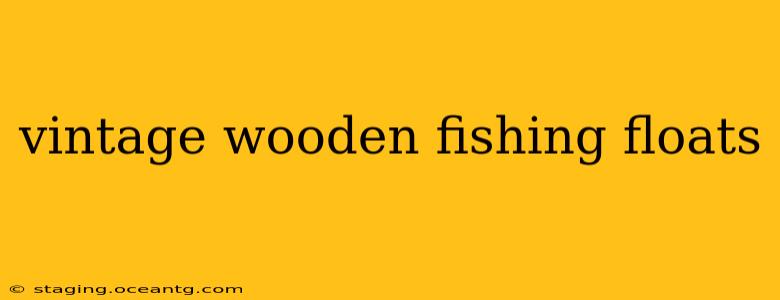Vintage wooden fishing floats, often referred to as fishing buoys or simply "floats," are more than just pieces of weathered wood. They represent a bygone era of fishing, a time before modern technology streamlined the process. These charming artifacts whisper tales of seafaring life, offering a captivating glimpse into maritime history and craftsmanship. Their unique shapes, colors, and weathered textures make them highly sought-after collectibles and decorative items. This guide delves into the world of vintage wooden fishing floats, exploring their history, identifying characteristics, and providing tips for collectors.
What Makes Vintage Wooden Fishing Floats Special?
The appeal of vintage wooden fishing floats extends beyond their nostalgic charm. Their inherent beauty lies in their handcrafted nature. Each float is unique, reflecting the individual skills and techniques of the craftsman who created it. The wood, often chosen for its buoyancy and durability (like cedar or pine), has aged gracefully over time, developing a patina that speaks of countless hours spent on the water. This natural aging process contributes to their distinctive character and collectible value.
How to Identify Authentic Vintage Wooden Fishing Floats
Authenticity is paramount in the world of collecting. Here's how to identify genuine vintage wooden fishing floats:
- Construction: Examine the construction. Look for hand-hewn markings, imperfections indicative of handmade craftsmanship, and signs of wear consistent with age and exposure to the elements. Machine-made floats often lack this character.
- Wood Type: Identify the wood type. Common woods include cedar, pine, and fir. The type of wood can provide clues about the float's origin and age.
- Paint and Markings: Pay attention to paint and markings. Original paint jobs, often faded and chipped, are a valuable indicator of age. Look for any markings, initials, or numbers that might offer clues to their origin or maker.
- Condition: Assess the condition carefully. While wear and tear are expected, significant damage can affect value. Consider the degree of weathering, cracks, and repairs.
What are the Different Types of Vintage Wooden Fishing Floats?
Vintage wooden fishing floats come in various shapes and sizes, reflecting regional differences and fishing techniques:
- Sphere: Classic spherical floats are common, providing good buoyancy and stability.
- Barrel: Barrel-shaped floats, wider in the middle and tapering at the ends, were often used in specific fishing methods.
- Pear: Pear-shaped floats offered a unique combination of buoyancy and stability.
- Other shapes: Unique and sometimes bizarre shapes can be found, depending on the region and the ingenuity of their creators.
Where Can You Find Vintage Wooden Fishing Floats?
Discovering vintage wooden fishing floats can be an exciting treasure hunt. Here are some places to explore:
- Antique Shops and Flea Markets: These are excellent starting points. You'll find a diverse range of floats, often at reasonable prices.
- Online Auction Sites: Online platforms offer a vast selection, connecting you with sellers worldwide. Remember to carefully examine photos and descriptions before bidding.
- Coastal Towns and Fishing Villages: Exploring coastal areas and fishing villages can sometimes uncover hidden gems. Local antique shops and even seaside markets may offer unique finds.
- Estate Sales and Auctions: Estate sales and auctions can provide unexpected discoveries, as vintage floats might be part of larger collections or family heirlooms.
How Much Are Vintage Wooden Fishing Floats Worth?
The value of vintage wooden fishing floats is highly variable and depends on several factors:
- Rarity: Unique shapes, sizes, and markings increase value.
- Condition: Well-preserved floats command higher prices than those with significant damage.
- Origin: Floats from specific regions or with known makers can be highly sought after.
- Overall Aesthetic Appeal: The overall beauty and charm of a float will influence its desirability.
Determining the precise value often requires consulting experienced collectors or appraisers.
How to Care for Your Vintage Wooden Fishing Floats?
Proper care preserves the beauty and value of your collection:
- Dust Regularly: Gentle dusting keeps your floats clean and prevents the buildup of dirt and grime.
- Avoid Direct Sunlight: Prolonged exposure to sunlight can cause fading and damage.
- Maintain a Stable Environment: Extreme temperature fluctuations and humidity can cause warping and cracking.
- Repair Carefully: Any repairs should be done by a professional conservator to maintain authenticity.
What are the best ways to display vintage wooden fishing floats?
Displaying your vintage wooden fishing floats is a chance to showcase their unique charm and add a nautical touch to your home décor. Consider these options:
- Individual Stands or Shelves: Highlight individual floats on custom-made stands or shelves, creating a museum-like display.
- Grouped Displays: Create a more casual atmosphere by grouping several floats together.
- Incorporated into Coastal Decor: Integrate the floats seamlessly into your overall coastal-themed décor.
This exploration of vintage wooden fishing floats offers a glimpse into their historical significance and collectible appeal. Remember that careful research, attention to detail, and a passion for maritime history are key to appreciating and preserving these unique nautical treasures.
